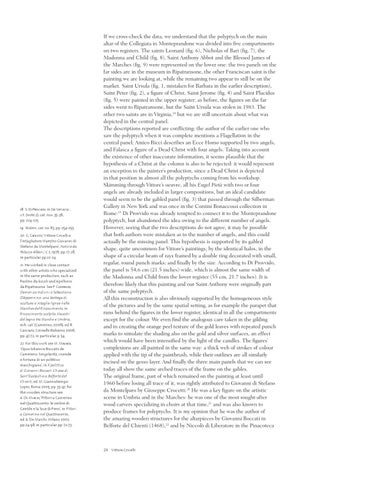18 S. Di Provvido, in Da Venezia… cit. (note 2), cat. nos. 35-36, pp. 224-225. 19 Ibidem, cat. no. 83, pp. 254-255. 20 G. Crocetti, ‘Vittore Crivelli e l’intagliatore Maestro Giovanni di Stefano da Montelparo’, Notizie da Palazzo Albani, V, 2, 1976, pp. 17-28, in particular pp.22-24. 21 He worked in close contact with other artists who specialized in the same production, such as Paolino da Ascoli and Apollonio da Ripatrasone. See F. Coltrinari, Domenico Indivini e Sebastiano D’Appennino: una bottega di scultura e intaglio ligneo nelle Marches del Rinascimento, in Rinascimento scolpito. Maestri del legno tra Marche e Umbria, exh. cat. (Camerino, 2006), ed. R. Casciaro, Cinisello Balsamo 2006, pp. 47-72, in particular p. 54. 22 For this work see M. Minardi, ‘Opus Iohannis Boccatii de Camereno. Singolarità, vicende e fortuna di un polittico marchigiano’, in Il polittico di Giovanni Boccati. Chiesa di Sant’Eustachio a Belforte del Chienti, ed. M. Giannatiempo Lopez, Roma 2005, pp. 35-47; for the wooden structure see A. De Marchi, ‘Pittori a Camerino nel Quattrocento: le ombre di Gentile e la luce di Piero’, in Pittori a Camerino nel Quattrocento, ed. A. De Marchi, Milano 2002, pp.24-98, in particular pp. 72-73.
If we cross-check the data, we understand that the polyptych on the main altar of the Collegiata in Monteprandone was divided into five compartments on two registers. The saints Leonard (fig. 6), Nicholas of Bari (fig. 7), the Madonna and Child (fig. 8), Saint Anthony Abbot and the Blessed James of the Marches (fig. 9) were represented on the lower one: the two panels on the far sides are in the museum in Ripatransone, the other Franciscan saint is the painting we are looking at, while the remaining two appear to still be on the market. Saint Ursula (fig. 1, mistaken for Barbara in the earlier description), Saint Peter (fig. 2), a figure of Christ, Saint Jerome (fig. 4) and Saint Placidus (fig. 5) were painted in the upper register; as before, the figures on the far sides went to Ripatransone, but the Saint Ursula was stolen in 1983. The other two saints are in Virginia,18 but we are still uncertain about what was depicted in the central panel. The descriptions reported are conflicting: the author of the earlier one who saw the polyptych when it was complete mentions a Flagellation in the central panel; Amico Ricci describes an Ecce Homo supported by two angels, and Falasca a figure of a Dead Christ with four angels. Taking into account the existence of other inaccurate information, it seems plausible that the hypothesis of a Christ at the column is also to be rejected: it would represent an exception in the painter’s production, since a Dead Christ is depicted in that position in almost all the polyptychs coming from his workshop. Skimming through Vittore’s oeuvre, all his Engel Pietà with two or four angels are already included in larger compositions, but an ideal candidate would seem to be the gabled panel (fig. 3) that passed through the Silberman Gallery in New York and was once in the Contini Bonaccossi collection in Rome:19 Di Provvido was already tempted to connect it to the Monteprandone polyptych, but abandoned the idea owing to the different number of angels. However, seeing that the two descriptions do not agree, it may be possible that both authors were mistaken as to the number of angels, and this could actually be the missing panel. This hypothesis is supported by its gabled shape, quite uncommon for Vittore’s paintings; by the identical halos, in the shape of a circular beam of rays framed by a double ring decorated with small, regular, round punch marks; and finally by the size. According to Di Provvido, the panel is 54,6 cm (21.5 inches) wide, which is almost the same width of the Madonna and Child from the lower register (55 cm, 21.7 inches). It is therefore likely that this painting and our Saint Anthony were originally part of the same polyptych. All this reconstruction is also obviously supported by the homogeneous style of the pictures and by the same spatial setting, as for example the parapet that runs behind the figures in the lower register, identical in all the compartments except for the colour. We even find the analogous care taken in the gilding and in creating the orange peel texture of the gold leaves with repeated punch marks to simulate the shading also on the gold and silver surfaces, an effect which would have been intensified by the light of the candles. The figures’ complexions are all painted in the same way: a thick web of strokes of colour applied with the tip of the paintbrush, while their outlines are all similarly incised on the gesso layer. And finally the three main panels that we can see today all show the same arched traces of the frame on the gables. The original frame, part of which remained on the painting at least until 1960 before losing all trace of it, was rightly attributed to Giovanni di Stefano da Montelparo by Giuseppe Crocetti.20 He was a key figure on the artistic scene in Umbria and in the Marches: he was one of the most sought-after wood carvers specializing in choirs at that time,21 and was also known to produce frames for polyptychs. It is my opinion that he was the author of the amazing wooden structures for the altarpieces by Giovanni Boccati in Belforte del Chienti (1468),22 and by Niccolò di Liberatore in the Pinacoteca
28 Vittore Crivelli
